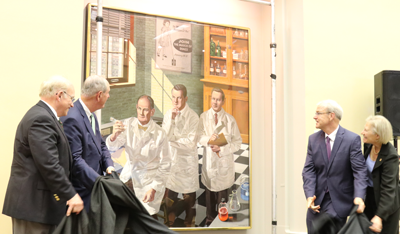 |
|
|
From left, Richard Pieters, Michael Collins, Terence Flotte and Michele Pugnaire unveil “Gateway to the Polio Vaccine.” |
A crowd gathered at the Lamar Soutter Library at UMass Medical School on Tuesday, May 29, to celebrate the intersection of art, science and medicine with the ceremonial unveiling of a painting commemorating the origin of the polio vaccine, an international medical milestone that took place in Massachusetts.
“Gateway to the Polio Vaccine” by Massachusetts artist Alan Witschonke depicts in photorealistic style three scientists at the moment of discovery. In 1948, Boston Children’s Hospital researchers John Enders, PhD, Frederick Robbins, MD, and Thomas Weller, MD, were able to grow the deadly polio virus in tissue culture. They won the Nobel Prize in Medicine or Physiology in 1954 for this essential precursor to the lifesaving polio vaccine that led to near-eradication of the disease worldwide.
“It is most fitting that this painting is being unveiled at our medical school as we are an institution that has long valued and celebrated the importance of the arts and humanities to the fields of science, medicine and nursing,” said Chancellor Michael F. Collins. “There will always be a special place for the arts and humanities here, because, more than just educating great scientists and caregivers, we’re in the business of nurturing and educating great people who have a deep appreciation for the humanistic qualities intrinsic to their professions.”
The painting was commissioned under the auspices of the Boston Medical Library, the archival repository for the Massachusetts Medical Society, led by Worcester and UMass Medical School icon Leonard Morse, MD.
Dr. Morse, retired professor of medicine, has served as Worcester Commissioner of Public Health, president of the Worcester District Medical Society, president of the Massachusetts Medical Society and president of the Boston Medical Library. A pioneer in public health campaigns, he spearheaded the initial program for polio vaccination in Worcester in 1963 with the Worcester District Medical Society.
“The portrait is in many ways a mini tribute to Lenny’s legacy. It captures a moment that was the pivotal step of harnessing the power of science to relieve human suffering,” said Terence R. Flotte, MD, the Celia and Isaac Haidak Professor of Medical Education, executive deputy chancellor, provost and dean of the School of Medicine. “This is the core mission of academic medicine. It is both medicine and science at their finest. And that, too, is the career of Dr. Morse.”
Morse observed the unveiling via livestream, with many on the speaking program addressing him directly. In turn, Dale Magee, MD, associate professor of obstetrics & gynecology, who in 2011 succeeded Morse as the Worcester commissioner of Public Health, read aloud his predecessor’s prepared comments.
“Growing up as a teenager in the 1940s, polio was always a concern. Fast forward to my career in medicine, when I chose infectious diseases as my field of interest,” Morse recalled. “As president of the BML, I was inspired by the paintings of the great moments in medicine displayed in the atrium of the building.
“With the help of an extended committee, hundreds of donations were collected to commission a painting of the conquest of poliomyelitis. I want to express my appreciation to the artist, and many thanks to all who made this event possible.”
On long-term loan from the Boston Medical Library, “Gateway to the Polio Vaccine” can be viewed near the Lamar Soutter Library entrance.